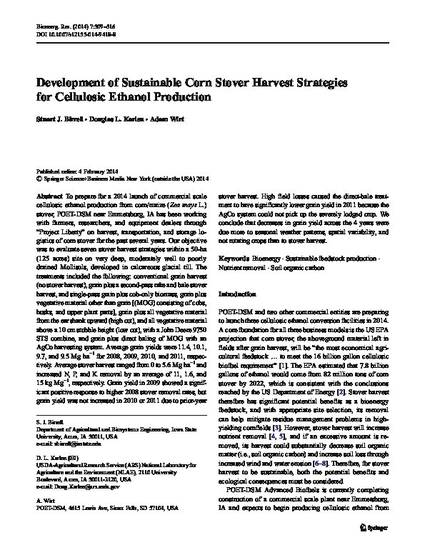
To prepare for a 2014 launch of commercial scale cellulosic ethanol production from corn/maize (Zea mays L.) stover, POET-DSM near Emmetsburg, IA has been working with farmers, researchers, and equipment dealers through “Project Liberty” on harvest, transportation, and storage logistics of corn stover for the past several years. Our objective was to evaluate seven stover harvest strategies within a 50-ha (125 acres) site on very deep, moderately well to poorly drained Mollisols, developed in calcareous glacial till. The treatments included the following: conventional grain harvest (no stover harvest), grain plus a second-pass rake and bale stover harvest, and single-pass grain plus cob-only biomass, grain plus vegetative material other than grain [(MOG) consisting of cobs, husks, and upper plant parts], grain plus all vegetative material from the ear shank upward (high cut), and all vegetative material above a 10 cm stubble height (low cut), with a John Deere 9750 STS combine, and grain plus direct baling of MOG with an AgCo harvesting system. Average grain yields were 11.4, 10.1, 9.7, and 9.5 Mg ha−1 for 2008, 2009, 2010, and 2011, respectively. Average stover harvest ranged from 0 to 5.6 Mg ha−1 and increased N, P, and K removal by an average of 11, 1.6, and 15 kg Mg−1, respectively. Grain yield in 2009 showed a significant positive response to higher 2008 stover removal rates, but grain yield was not increased in 2010 or 2011 due to prior-year stover harvest. High field losses caused the direct-bale treatment to have significantly lower grain yield in 2011 because the AgCo system could not pick up the severely lodged crop. We conclude that decreases in grain yield across the 4 years were due more to seasonal weather patterns, spatial variability, and not rotating crops than to stover harvest.
Available at: http://works.bepress.com/stuart_birrell/3/

This article is from BioEnergy Research 7 (2014): 509–516, doi:10.1007/s12155-014-9418-8.